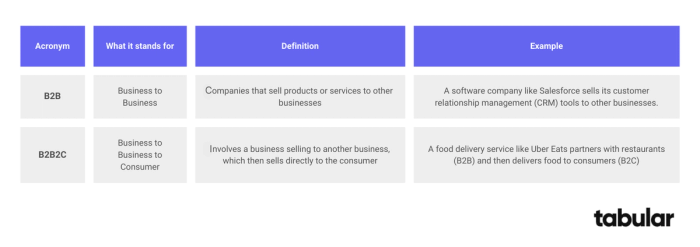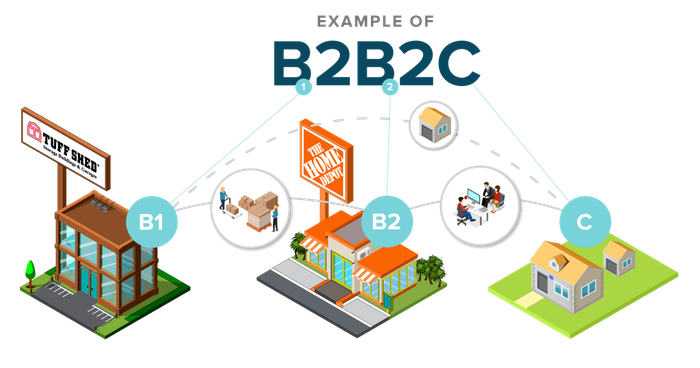What Is B2B2C and How It Works
Table of contents
"B2B2C" is short for Business-to-Business-to-Consumer. "B2B2C" is a business model where two companies partner together to deliver products or services to the end consumer.
First Business (B1): This is typically the manufacturer or original service provider. They create the product or service.
Second Business (B2): This is an intermediary business, often a retailer, service provider, or platform. They act as a conduit, taking the product or service from B1 and making it accessible to the end consumer.
Consumer (C): This is the individual who ultimately purchases and uses the product or service.
A great example is Amazon Marketplace. Amazon partners with third-party sellers (B2B) who list their products on the platform. Consumers shop for these products on Amazon’s site, and Amazon handles the customer-facing aspects, such as payments, customer service, and delivery. This arrangement benefits sellers by providing access to a large customer base, while consumers get a wide variety of products conveniently in one place.
Marketing is all about reaching the right customers more. Marketing strategies revolve around attracting new customers while retaining existing ones.
Today, we'll explore a hybrid approach that blends B2B and B2C models to form Business to Business to Consumer, also known as B2B2C marketing.
We'll discuss the meaning of B2B2C, which products or services align best with this model, and how you can incorporate it into your marketing plan. Let's begin with some definitions.
What is B2B2C?
To begin with the fundamentals, let’s define the B2B2C meaning. It stands for Business to Business to Consumer, which involves selling products or services through another business. Essentially, it allows you to reach the other company’s existing customer base and redirect them to your brand.

To clarify what B2B2C is, we can look at examples. B2B2C model is commonly used in traditional distribution channels and reselling. Major companies like Google, Amazon, and Alibaba successfully apply this model for reselling purposes.
For instance, if you're a small local brand, your visibility may be limited, but through a platform like Alibaba, customers worldwide can find your products. But how exactly does this model operate?
How Does the B2B2C Business Model Work?
The B2B2C business model often involves online retailers and marketplaces that use an intermediary company to sell products or services. Let’s break it down step-by-step.
- First, you, as the developer or manufacturer, create the product or service and aim to reach a broader customer base.
- Next, an intermediary business, which has an extensive consumer reach, enters the picture. This company might sell its own products to a trusted audience or act purely as a reseller. You collaborate with them to have your product included in their catalog.
- Finally, the consumer, who is looking for your specific product, finds it through the intermediary business and experiences your offering.
A great example of B2B2C companies is Google’s partnerships, such as Google Cloud services. Even if you're a startup, you can use these services to promote your brand or product.
B2B2C vs. B2B: What’s the Difference?
If all these acronyms seem overwhelming, let’s simplify things. A common question is why choose B2B2C when B2B seems like a simpler option. There are some important distinctions.

B2B involves a business selling its product or service directly to another business. Once the product is sold, your involvement ends, which can save effort. However, if the buyer expands or repackages your product, they retain all revenue and credit. For example, IBM sells exclusively to other businesses.
In contrast, B2B2C may require more work, but it allows you to engage directly with the end consumer. You maintain control over the product’s marketing and can even use platforms like Alibaba to reach a wider audience, ultimately guiding consumers toward your own services in the future.
B2B vs. B2C vs. B2B2C vs. B2C2B: A Comparison
| B2B | B2C | B2B2C | B2C2B | |
|---|---|---|---|---|
| Target Audience | Businesses and professionals | Individual consumers | Businesses that sell to end consumers | Individual consumers influencing business adoption |
| Sales Process | Longer sales cycle, relationship-driven | Shorter sales cycle, direct purchase | Business partnership for consumer reach | Individual adoption leads to team/business adoption |
| Marketing Focus | Emphasizes ROI, value, and relationship-building | Focuses on emotional appeal, benefits, and ease | Benefits for both business partners and consumers | Highlights individual benefits with a business value focus |
| Product Complexity | High-ticket products/services | Mass-market, easy-to-use products | Consumer-oriented products delivered through business partnerships. | Simple for individuals, scalable for team/business needs |
| Pricing Structure | Often negotiated contracts or custom pricing | Fixed, transparent pricing | Partner-specific pricing; end consumer sees standard rates | Starts with individual pricing, scales to team/business packages |
| Customer Journey | Multi-step, multiple decision-makers | Straightforward, individual purchase path | Business partners manage consumer acquisition | Begins with individuals, expands to team/company use |
| Sales Channel | Direct sales, partnerships, account management | E-commerce, retail, digital marketing | Partner-based distribution channels to reach consumers | Digital platforms targeting both individuals and businesses |
| Lifetime Value (LTV) | High LTV with longer contracts/subscriptions | Lower LTV per individual, higher volume | LTV depends on business partnerships and consumer reach | LTV grows as adoption scales from individuals to company-wide |
Key Strategies for Effective B2B2C Marketing
B2B2C marketing highlights the need to build strong connections with both intermediaries and end consumers. To create effective marketing strategies, you should prioritize key elements:
- Focus on End-User Experience: While you’re selling to another business, your ultimate goal is the end user. Therefore, you must prioritize the consumer journey. Ensure you offer seamless navigation to customer support, repair services, or related products.
- Partner with the Right Intermediaries: Since you’ve invested significant time and effort into building your brand, selecting the right partner is crucial. Choose intermediaries that align with your brand values and can effectively reach your target audience.
- Personalization and Data Usage: Building long-term relationships with consumers is essential. Use personalized marketing efforts and optimize data usage. Even through an intermediary, you can apply personalization strategies.
- Effective Communication: Maintain a direct line with buyers by sending personalized welcome emails, even if they purchased through a partner. Providing customer service remains vital.
Successful B2B2C Companies and Examples
While we could discuss the advantages of B2B2C companies at length, it’s more impactful to demonstrate their success. Here’s a brief look at why certain B2B2C companies are thriving:
Amazon: As one of the most popular platforms for resellers, Amazon enables you to sell directly to consumers while it manages logistics and customer service. This means you don’t have to worry about those processes at all.
Uber Eats: Expanding your food delivery can significantly increase sales, but fulfilling every order can be challenging. Uber Eats acts as an intermediary platform, allowing you to reach more customers than your in-house capacity would allow.
Google Cloud: Offering services through partners, Google Cloud operates in a similar way to other B2B2C models. By partnering with them, you can deliver your services to other businesses while benefiting from the trust and reliability associated with Google.

Benefits of the B2B2C Model
B2B2C marketing strategies can drive significant sales and foster growth for your business. Here are some examples of how this model benefits brand identity:
- Wider Market Reach: Many marketing strategies aim to attract new customers, and the B2B2C model allows you to tap into a larger market through a middle company.
- Shared Resources: By working with an intermediary business, you don’t have to handle all the marketing, distribution, logistics, or other operational costs. They assist you with these processes.
- Brand Exposure: With B2B2C marketing, the intermediary platform markets your products, reducing the need for word-of-mouth promotion. Their reach extends your brand exposure effortlessly.
- Scalability: The sales data generated through the intermediary can help you refine your products and services. B2B2C companies also enhance scalability by managing consumer-facing operations.
Challenges of the B2B2C Business Model
Every successful model comes with its own challenges. Here are some of the potential hurdles in the B2B2C business model:
- Limited Control Over Consumer Experience: While intermediaries manage many aspects of the process, they also influence the customer journey, limiting your ability to direct the consumer experience.
- Brand Dilution: You've invested time in building your brand identity, but the platform you're selling through may not share your values. As a result, your brand may not be adequately represented.
- Pricing Conflicts: When the intermediary controls part of the selling process, you may lose decision-making power. This can lead to pricing conflicts that could harm your business.
Conclusion
In this article, we've explored the B2B2C meaning and how to incorporate it into your business marketing strategy. With a business-to-business-to-consumer approach, you can reach a broader audience that may be interested in your products or services. By carefully selecting the right intermediary business, you can discover new potential customers.
If you're looking to expand your reach without handling billing, shipping, or marketing yourself, the B2B2C model can be a great solution. The intermediary leverages their existing customer base to promote your offerings. However, keep in mind that you may need to relinquish some control over the process as you're not involved in the later stages.
We hope this article has given you insights into how you can implement this strategy in your own business plan, supported by examples of B2B2C companies. Happy emailing!